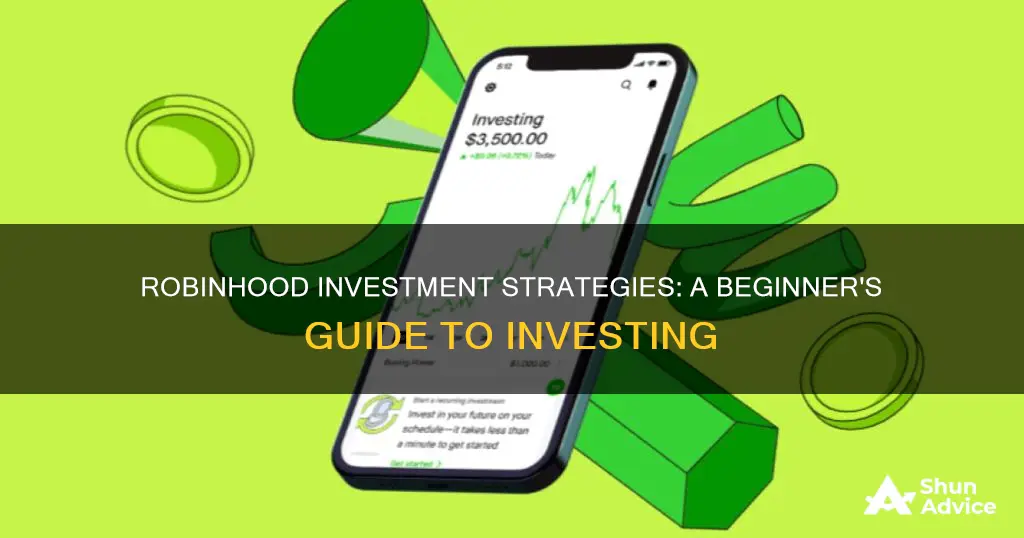
Investing on the Robinhood platform is a straightforward process. First, you need to decide whether to use the web-based version or download the mobile app. Then, you create an account, providing personal details and answering questions about your investing experience. You can then add stocks to your watchlist, link your bank account, and deposit money. When it comes to choosing stocks, it's important to consider your goals and timeframe. You can also look at what professional analysts are saying, the average price paid by users, and the company's earnings and current involvements. Robinhood offers a range of investment options, including stocks, options, ETFs, and cryptocurrencies, with no commission fees.
| Characteristics | Values |
|---|---|
| Investment options | Stocks, ETFs, options, ADRs, futures, crypto |
| Number of securities | Over 10,818 |
| Supported assets | US exchange-listed stocks and ETFs, options contracts for US exchange-listed stocks and ETFs, ADRs for over 519 globally-listed companies |
| Non-supported assets | Foreign-domiciled stocks, bonds, fixed-income trading, stocks that trade on foreign exchanges, limited partnerships, New York registry shares, sanctioned securities affected by the White House’s executive order from Nov. 12, 2020 |
| Subscription | Gold ($5/month) |
| Minimum investment | $1 |
| Commission fees | None |
| Account verification | Driver’s license, Social Security number, address, birthday |
| Watchlist | Industries or companies of interest |
| Bank account | Routing number and account number |
| Investment goals | Short-term, mid-term, long-term |
| Investment strategies | Market buy, market order |
What You'll Learn

How to set up a Robinhood account
To set up a Robinhood account, you will need to meet the following requirements:
- Be 18 years or older
- Have a valid Social Security Number
- Have a legal United States (US) residential address within the 50 states, Puerto Rico, or the US Virgin Islands (exceptions may apply for active US military personnel stationed abroad)
- Be a US citizen, US permanent resident, or have a valid US visa
You will also need to have a device that meets Robinhood's technology requirements. Robinhood is currently available on iOS, Android, and most web browsers.
Setting up an account is simple and can be done in five steps:
- Set up an account: Visit Robinhood's sign-up page and click "open an account." Provide an email address and password, followed by your legal name as it appears on a government ID. You will then be asked to fill in some basic information, such as your phone number, date of birth, residential address, and citizenship.
- Verify your identity: Robinhood will require your Social Security Number to verify your identity.
- Provide your investing experience: You will be asked some questions about your investing experience. You will also be asked if you would like to enable commission-free options trading.
- Review agreements: You will be asked to review and agree to two different agreements: the Tax Certification and the brokerage agreement.
- Fund your account: You can fund your Robinhood account with as little as $1. You can link your bank account through Plaid or choose from a list of financial institutions.
Once you have completed these steps, you will receive an email confirming your application's approval or requesting additional information. If your application is approved, you will receive instructions on getting started with your new Robinhood account.
Building a Million-Dollar Investment Portfolio: Strategies for Success
You may want to see also

How to choose stocks to invest in
When it comes to choosing stocks to invest in on Robinhood, there are several factors and strategies to consider. Here are some guidelines to help you make informed decisions:
- Define your investment goals and timeframe: Before choosing specific stocks, it's essential to determine your investment objectives and how long you plan to invest. Are you looking for short-term gains or long-term growth? This will impact the types of stocks you select.
- Diversify your portfolio: Diversification is a risk management strategy. By investing in a variety of stocks across different assets or industries, you reduce the impact of any single stock on your overall portfolio. This way, if one stock underperforms, it won't affect your entire investment.
- Research and analyse stocks:
- Watchlists and Popular Lists: Start by adding stocks you're interested in to your watchlist on Robinhood. Monitor their performance and look at the "People Also Bought" section and the popular lists to see what stocks are priced where.
- Stock Performance: If a stock is at a 52-week high, you may want to wait for it to become cheaper before investing. Conversely, if a stock is at a 52-week low, wait for an upswing before investing. Some stocks have longer periods of growth, while others fluctuate more frequently.
- Professional Analysts' Recommendations: Consider the recommendations of professional stock analysts. If a stock has a consensus "sell" rating, it may be best to look elsewhere.
- Average Price Paid by Users: Look at the average price paid by other users. Buying below or near the average price is often a better strategy than buying at peak prices.
- Earnings and Performance: Review the company's financial health by checking its PE ratio (price-earnings ratio) and its projected vs. actual earnings per share. This information is available on Robinhood by scrolling down a stock's sale page.
- Consider your risk tolerance: Investing in stocks always carries some level of risk. Assess your risk tolerance and choose stocks that align with your comfort level. Diversification can also help mitigate risk.
- Stay informed: Keep up with news and developments related to the companies you're investing in or considering. Company announcements, legal issues, or industry trends can impact stock performance.
- Start with a small investment: When you're starting, it's advisable to invest a small amount of money to minimize the risk of loss. As you gain experience and confidence, you can adjust your investment strategies accordingly.
- Avoid hype stocks: Hype stocks are those that attract a lot of attention and often experience rapid price increases. However, they can be highly volatile and may not be suitable for long-term investing.
Remember, investing in stocks requires careful consideration and a long-term perspective. Always do your research, stay informed, and consider diversifying your portfolio to manage risk effectively.
Unlocking Private Equity Investment: A Guide to Getting Started
You may want to see also

How to deposit money into your account
To deposit money into your Robinhood account, you will first need to create an account. You will need to provide your driver's license, Social Security number, address, and birthday. They will also ask you a few questions about your investing experience to ensure that all the financials are legal and that you are not a majority stakeholder in any stock before your account is approved.
Once your account is set up, you can add a bank account to facilitate depositing and withdrawing money. During the registration process or after you have selected the companies you want to invest in, go to the "Account" tab and click "Banking." Under your name, you will see a button that says "Add an Account." Here, you will need to provide the routing number and account number for the bank account. Robinhood will make two small charges to verify that the bank account has funds, and upon successful verification of your identity, you will be ready to invest.
After linking your bank account, you can deposit money into your Robinhood account. The amount you deposit is up to you and can be based on the specific stocks you want to purchase. Generally, the more you invest, the greater the potential returns. However, it is recommended to start with a small amount of money to lower the risk of losing money, especially when beginning your investment journey.
Creating an Investment Schedule: Strategies for Success
You may want to see also

How to buy and sell stocks
To get started with investing in stocks on Robinhood, you need to open an account, deposit money, and select stocks. You can start investing with as little as $1. Robinhood offers commission-free investing in stocks, ETFs, and their options.
Robinhood offers a variety of assets to invest in, including US exchange-listed stocks and ETFs, options contracts for US exchange-listed stocks and ETFs, and ADRs for over 519 globally-listed companies.
Buying Stocks:
- Go to the stock's detail page to view the stock's historical performance, analyst ratings, company earnings, and other helpful information to consider when buying a stock.
- Select "Trade" and then "Buy" or simply "Buy" if you don't currently own the stock.
- By default, you will be asked to enter the amount you would like to purchase in dollars, or you can choose to buy shares or select another order type.
- Review your order and confirm that all the details are correct. You can also edit your order if needed.
- If all looks good, swipe up to submit your order.
Selling Stocks:
- Go to the stock's detail page to view the stock's historical performance, analyst ratings, company earnings, and other helpful information to consider when selling a stock.
- Select "Trade" and then "Sell".
- Choose your order type in the top right corner.
- Enter your order details, such as the number of shares or the dollar amount you want to sell.
- Review your order and confirm that all the details are correct. You can also edit your order if needed.
- If all looks good, select "Sell" to submit your order.
Keep in mind that during regular market hours (9:30 AM-4 PM ET), dollar-based buy orders are entered as market orders, while share-based buy orders are entered as limit orders with a preset limit price. During extended hours (7-9:30 AM and 4-8 PM ET), both dollar-based and share-based buy orders are entered as limit orders with a preset limit price.
Additionally, when placing a market sell order, note that the last traded price may not be the price at which your order will be executed.
Smart Strategies to Turn $100K into $1 Million
You may want to see also

How to diversify your portfolio
Diversifying your portfolio is a crucial step in reaching your long-term investment goals. Here are some detailed tips on how to diversify your portfolio:
Know Your Risk Tolerance and Investment Goals
Before investing, it is essential to assess your risk tolerance and define your investment goals. Ask yourself how much risk you are comfortable taking and what you hope to achieve with your investments. Are you investing for retirement, to save for an emergency fund, or to pay off debt? Knowing your risk tolerance and goals will help guide your diversification strategy.
Diversify Across Different Asset Classes
Spread your investments across different asset classes, such as stocks, bonds, cash, real estate, commodities, and alternative investments. By allocating your money to various asset classes, you reduce the likelihood of experiencing significant losses if one particular asset class underperforms.
Diversify Within Asset Classes
Diversification doesn't stop at the asset class level. Within each asset class, you can further diversify by investing in different companies, industry sectors, geographies, and currencies. For example, rather than investing all your money in the stock of a single company, spread your investments across multiple companies and industries.
Consider Index Funds, Mutual Funds, and ETFs
Index funds, mutual funds, and exchange-traded funds (ETFs) are excellent tools for diversification. These funds typically hold a variety of assets, making it easier to achieve a well-diversified portfolio. Mutual funds and ETFs are particularly useful for diversifying within asset classes, as they invest in a diverse range of companies.
Regularly Review and Rebalance Your Portfolio
Diversification is an ongoing process. Regularly review your portfolio to ensure it aligns with your investment goals and risk tolerance. Over time, the performance of different investments will cause the allocation of your portfolio to shift. Rebalancing involves adjusting your portfolio to return it to your desired allocation.
Be Mindful of Costs and Fees
When diversifying your portfolio, be mindful of the costs and fees associated with different investment options. Mutual funds and ETFs, for example, often charge management fees. Understand what you are paying for and whether there are any hidden costs or trading commissions.
Remember, diversification does not guarantee profit or eliminate the risk of losses. However, by following these steps, you can create a robust, diversified portfolio that helps mitigate potential losses and smoothens returns.
Certificate of Deposit: Investment or Savings?
You may want to see also
Frequently asked questions
You can use the web-based version of Robinhood or download the app on the Apple App Store or Google Play Store. Then, create an account, and you will be prompted to select some industries that you would like to invest in. You can also add stocks to your watchlist.
Robinhood offers a variety of assets to invest in, including stocks, options, and exchange-traded funds (ETFs). You can also trade certain crypto through a separate account with Robinhood Crypto.
You can start investing on Robinhood with as little as $1.
It is important to consider your investing goals and timeframe. You can also look at what professional stock analysts are saying, the average price paid by users, the company's earnings, and current involvements.
Educate yourself about the trades you are making and start by investing a small amount of money to lower your risk of losing money. It is also a good idea to split your money between multiple different investments to reduce your risk.
BONUS: What are some downsides to investing on Robinhood?







